Basics of Discounted Cash Flow
Discounted Cash Flow (DCF) is a method of estimating what an asset is worth today by using projected cash flows. It tells you how much money you can spend on the investment right now in order to get the desired return in the future. Discounted cash flow analysis can help determine if an investment is worthwhile, whether you want to calculate the value of:
- Another business
- A bond
- Stock
- Real estate
- Equipment
- Any long-term asset
It can also be used for reasons other than buying another company. The financial modeling method can be used to help someone determine if making a big purchase is a good long-term investment. If you want to buy an expensive piece of equipment, you can use the Discounted Cash Flow method of analysis to help you determine if it’s a good long-term investment.
The DCF analysis operates under the time value of money principle. This concept assumes that money is worth more today than it is in the future. For example, $100 is worth more now than it would be a year from now because of interest and inflation rates. If you’re going to spend $100 dollars to buy something, you’re going to want to know how much money you’ll get in return and what that money will be worth in the future. And that’s where the Discounted Cash Flow method can help. The elements in a Discounted Cash Flow analysis are:
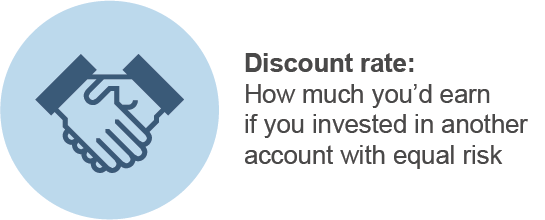
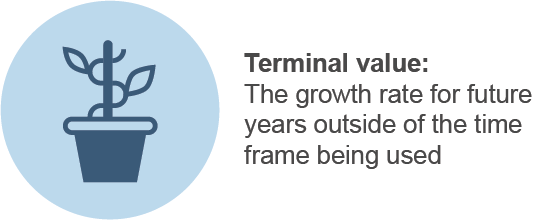

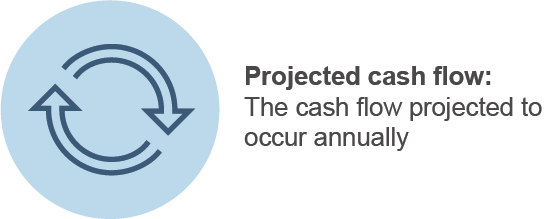
- Periods of time.
- The projected cash flow that will occur every year.
- A discount rate or annual rate. The discount rate could be thought of as how much money you’d earn if you invested it in another account with equal risk.
- The terminal value. This number represents the perpetual growth rate for future years outside of the timeframe being used.
The method uses the projected cash flow and discounts them using an annual rate, which results in a present value estimate. The net present value (NPV) estimate is then used to determine the potential for investment.
Discounted Cash Flow Calculation (DCF Formula)
The Discounted Cash Flow calculation or DCF formula can be as simple or complex as you want. To get started, use this formula:

(Cash flow for the first year / (1+r)1)+(Cash flow for the second year / (1+r)2)+(Cash flow for N year / (1+r)N)+(Cash flow for final year / (1+r)
In the formula, cash flow is the amount of money coming in and out of the company. For a bond, the cash flow would consist of the interest and principal payments.
R represents the discount rate, which can be a simple percentage, such as the interest rate, or it’s common to use the weighted average cost of capital. The discount rate represents the required rate of return for investors to receive the money they’re receiving. For a bond, a discount rate would be the interest rate.
The weighted average cost of capital is the rate a company pays to finance its assets. It includes the average cost of a company’s working capital after taxes. This can include common and preferred stock, bonds or long-term debt.
N represents the period of time. A business owner can use as many cash projections as they want for the Discounted Cash Flow analysis – it can be five years, 10 years or even longer.
The final calculation at the end of the formula is considered the terminal value. This represents the growth rate for projected cash flows for the years outside of the timeframe you’re using.
To find the terminal value, take the cash flow of the final year, multiply it by (1+ long-term growth rate in decimal form) and divide it by the discount rate minus the long-term growth rate in decimal form.
Finding the necessary information to complete a DCF analysis can be a lot of work. But when you’re able to plug in the information into the formula, it becomes a simple calculation. And why do you discount cash flows? Once you get the DCF valuation from the formula, you can use the number to determine if it makes sense to make an investment. You can also look for discounted cash flow calculators online to help.

Discounted Cash Flow Valuation Formula
If you wanted to do a Discounted Cash Flow analysis of a company or any long-term asset, you would have to first estimate its future cash flows. To get started, take a look at the balance sheet, showing the money that went in and out of the company during the previous year. Let’s say the company’s cash flow in the previous year was $25 million.
To determine the company’s growth rate, you can compare the previous year’s cash flow with earlier years. For example, if the company’s cash flow in 2017 was $25 million, you can compare that number to the cash flow in 2016 and determine how much it grew by. You can use the growth rate from this comparison as an estimate of how much the company will grow in the future.
Let’s say the company is estimated to grow 5% in the first two years and then 2% in the following three years.
You should also choose a percentage to calculate the terminal value. This number represents the long-term growth of the company. Try to be a little conservative with this; let’s say the long-term growth rate for the company is 3%—the growth rate in the U.S.
With this information, you can now calculate projected cash flow for each year you’re looking at.
| Year 1 | =25 * 1.05 | 26.25 |
| Year 2 | =26.25 * 1.05 | 27.56 |
| Year 3 | =27.56 * 1.02 | 28.11 |
| Year 4 | =28.11 * 1.02 | 28.67 |
| Year 5 | =28.67 * 1.02 | 29.24 |
| Terminal Value | =29.24 (1.03) / (0.04 – 0.03) | 3011.72 |
You now have three of the necessary elements to complete a Discounted Cash Flow analysis. Now you also need to calculate the weighted average cost of capital, or the discount rate. To calculate the weighted average cost of capital, use this formula:
(Market value of company equity / (the sum of the market value of the company equity and company debt)) * Cost of Equity + (Market value of company debt / (the sum of the market value of the company equity and company debt)) * Cost of Debt *(1 – Corporate Tax Rate)
In this example, let’s say the company’s discount rate is 4%.
With these numbers, you can now plug them into the formula to complete a Discounted Cash Flow analysis of the company:
(26.25 / 1.041)+(27.56 / 1.042)+(28.11 / 1.043)+(28.67 / 1.044)+(29.24 / 1.045)+(3011.72 / 1.045)
= 25.24+25.48+24.99+24.51+24.03+2475.41
Discounted Cash Flow of the company = 2,599.66
With the Discounted Cash Flow analysis, the value of the company is $2.09 billion. If an investor were to pay less than this amount, the rate of return would be higher than the discount rate. Paying more than the Discounted Cash Flow analysis value could mean a lower rate of return than the discount rate. You can also look to the company’s current stock price to determine if there’s a good investment; if the Discounted Cash Flow value is higher than the stock price, it can be a good investment.
If you want to perform a Discounted Cash Flow analysis on the computer with Microsoft Excel, there isn’t a specific formula for it. However, you can set up a spreadsheet to perform the projected cash flow calculations for you, as well as the overall Discounted Cash Flow formula.
Here’s an example of what an Excel spreadsheet for a Discounted Cash Flow analysis looks like:


A downside to Discounted Cash Flow analysis is that the formula requires accurate numbers. Because the analysis is dependent on the data being plugged into the formula, any errors can result in a wrong value. Mistakes can lead to making the wrong investment banking decision.
Letting computer software, such as Excel, handle the calculations can prevent mathematical mistakes while performing a Discounted Cash Flow analysis.
Other common mistakes when doing a Discounted Cash Flow analysis is not using enough of a time period in the calculation. The Discounted Cash Flow value for a formula using two years of projected cash flow is very different than the results from a formula using five years of cash flow.
How to Come Up With the Right Time Frame
When it comes to determining how much time to include in the Discounted Cash Flow formula, there is no clear right or wrong answer. Some may favor looking at a shorter timeframe, such as two to five years, and others may favor using at least 10 years’ worth of cash flows.
Knowing whether to look at a shorter timeframe versus a longer timeframe is largely dependent on the type of asset being valued. If you’re looking to invest in a piece of equipment, you can use a shorter timeframe. But when you’re trying to acquire another business, consider looking at a longer timeframe of 10 years.
A good place to start when figuring out how much time to look at is the IRS depreciation guidelines. The IRS categorizes different types of property under depreciation timeframes. Here are some examples:
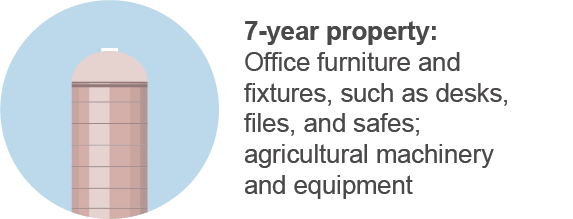

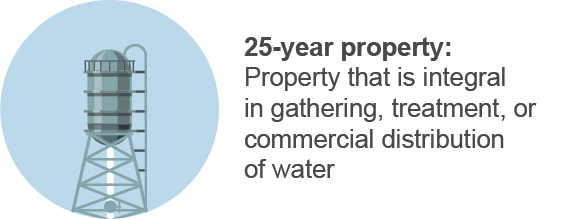
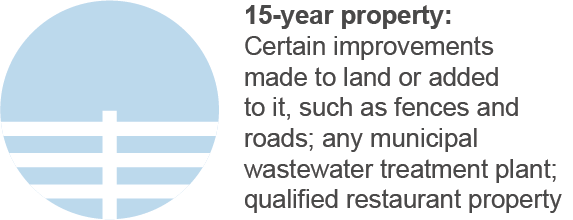

- 7-year property: Office furniture and fixtures, such as desks, files, and safes; agricultural machinery and equipment
- 10-year property: Any single purpose agricultural or horticultural structure
- 15-year property: Certain improvements made to land or added to it, such as fences, roads, sidewalks, bridges; any municipal wastewater treatment plant; qualified restaurant property
- 20-year property: Farm buildings, municipal sewers
- 25-year property: Property that is integral in gathering, treatment or commercial distribution of water
Depending on if you’re purchasing a building or piece of equipment, using the IRS’ guidelines as the timeframe in the Discounted Cash Flow analysis can be helpful.
It’s important to know that these are just guidelines and not rules you have to stick by. Even if you’re looking to invest and buy another company, certain factors may cause you to look at a shorter timeframe than 10 years. For example, if it can’t be proven the company being acquired can continue to be successful and provide a return on the investment after three or four years, it doesn’t make sense to use a timeframe longer than that in the Discounted Cash Flow analysis.

How to Determine the Correct Interest/Discount Rate
It’s best to be as conservative as possible when it comes to the discount rate for the Discounted Cash Flow model.
The discount rate can significantly affect the Discounted Cash Flow analysis; changing the discount rate alters the value. If too high of a discount rate is chosen, it can make the investment less valuable.
A good guideline to follow is to use the current interest rates. Let’s say you were going to buy an asset for $200,000. If you took out a loan for that amount, the interest rate can range between 4.25% to 4.5%, depending on the length of the loan. You can use a discount rate between 4.25% and 4.5% in the Discounted Cash Flow formula.
It’s also a good idea to keep in mind the inflation rate when choosing a discounted cash flow. The current inflation rate in 2018 is about 2%. Although it’s a good principle to be conservative with values when it comes to the Discounted Cash Flow analysis, there is such a thing as being too conservative with the discount rate.
If you were to invest $100 in a piece of equipment, but used a 0% discount rate in the Discounted Cash Flow formula, you’re assuming the $100 spent today will have the same worth in the future, which isn’t true.

Discounted Cash Flow Modeling Analysis
Let’s say the Discounted Cash Flow for a company is $500 million. How do you use this information?
The Discounted Cash Flow analysis not only tells you the estimated value of a company, but it also is supposed to tell you the rate of return you would get if you invested. If an investor were to buy the company in the example above for more than $500 million, the rate of return on their investment would be lower than the discount rate used in the Discounted Cash Flow analysis. If the investor buys the company for less than $500 million, the rate of return would be higher than the discount rate.
You can also look at the company’s stock price and compare it to the Discounted Cash Flow value. If the Discounted Cash Flow value is higher than the stock price, the investment may be a good opportunity.
What if you were to change one of the values in the Discounted Cash Flow? How would that impact the result of the Discounted Cash Flow analysis?
One of the downsides of the Discounted Cash Flow analysis is that the result is truly based off the numbers put into the formula. If overly optimistic cash flows are projected, it results in a higher value for the company. If lower numbers are put into the formula, the value is lower. For example, the terminal value in the Discounted Cash Flow analysis accounts for a large percentage—over half—of the total value of the company being evaluated. Any fluctuations with the terminal value can significantly impact the result of the Discounted Cash Flow calculation.
You can use Excel to run a sensitivity analysis. Sensitivity analysis lets you see how different values for one independent variable can affect a dependent variable.
Here’s an example of a sensitivity analysis using a discounted cash flow valuation model in Excel:

Limitations of Discounted Cash Flow Analysis
The Discounted Cash Flow model can be a very helpful tool for those working in the financial industry, as well as the small business owner. But there are limitations with the model to consider.
It’s important to try to be realistic when making predictions. It’s possible for projections of future cash flow to be inflated when doing a Discounted Cash Flow analysis. The Discounted Cash Flow analysis relies on the information plugged into it, so the end result is dependent on what numbers are used in the formula. It’s also important to note that if you miscalculate your projected cash flows or a part of the Discounted Cash Flow formula, you won’t get an accurate result.
Generally, the numbers used for a Discounted Cash Flow analysis aren’t based on actual data. The cash flow amounts are projections and you have to predict the growth rate of the company you’re trying to find the value of. Although you can predict what next year’s cash flow would be by using the current and previous year’s data, projections farther in the future are assumed. It’s hard, if not impossible, to predict how a business is actually going to perform in the future and how it will be impacted by the market. And even if the company does experience growth in the future, it could be higher—or lower— than the rate used in the Discounted Cash Flow analysis.
The terminal rate, or the percentage used in the Discounted Cash Flow formula to represent growth for all future years of the company’s existence, is usually 3%. That’s because it represents the growth rate in the U.S. But the terminal rate shouldn’t be 3% for some companies because the economy grows when new companies startup. For a company that has been in business for a long time, 3% could be too high of a rate. If that’s the case, the Discounted Cash Flow analysis gives a valuation that’s higher than what the company may actually be worth.
The terminal rate or terminal value also accounts for a large portion of the estimated value from the Discounted Cash Flow analysis. Changing the terminal rate slightly could result in large fluctuations with the result you’d get from the analysis. So, it’s important to make sure you’re using the most accurate data for the calculation.
The limitations with the terminal rate apply to the overall growth rate for the timeframe being used in the Discounted Cash Flow. The assumption is the company will experience growth at a certain percentage the longer the company is in business. But the growth rate chosen to be used in the analysis is a prediction.
As with any valuation model, it’s important to keep things up to date. With the Discounted Cash Flow formula requiring numerous elements, analysts may not place as much of an emphasis on focusing on any outside factors that can impact the company, such as competition. If you’re only using the Discounted Cash Flow regularly, consider going back to your analysis in the future and comparing it to the actual cost and figures. By doing this, you can see how accurate you were with your projections and if there’s a certain area of the formula you should work on for future asset investments.
Although the Discounted Cash Flow analysis is commonly used, it’s important to understand its limitations. The calculation is only as good as the information put into it. Because the method is based heavily on projections and assumptions of a company’s performance in the future, the Discounted Cash Flow analysis can be used in parallel with other valuation models to provide a more accurate picture.
Pitfalls to Avoid When Forecasting Cash Flow

Avoid being too optimistic with cash flow projections. When it comes to the Discounted Cash flow analysis, stray on the conservative side.
It’s easy to look at an asset and overestimate how much money it will make in the future. This leads to a higher result and it may not be an accurate valuation.
Using as much information and data to make projections can help keep the estimates realistic. Spend time comparing cash flows from previous years to get a better sense of how much the company grew. By using real numbers and data, you can see how much the company’s revenues grew over time. And you can use any trends to base your projected cash flows off of.
If you use inflated numbers for the Discounted Cash Flow formula, you’ll likely get a high value as a result. And this could impact your decision on whether or not to make the investment. Be realistic and conservative when dealing with projected cash flows—it could help you make a better decision. Try to avoid making these three discounted cash flow mistakes in your calculations.

Alternative Formulas and Methods
Since the Discounted Cash Flow formula is based on assumptions, another method that could be used is the Comparables Method. It compares various elements to calculate the value of a company. For example, a Comparables Method may compare price to sales as a valuation method.
The advantages the Comparables Method has over the Discounted Cash Flow formula is that it doesn’t rely so much on predictions to come up with a valuation. And with the elements used, the Comparables Method shows how well a business is performing in the current marketplace. The Discounted Cash Flow formula gives you a prediction of how the company will perform in the future, not how it currently is performing.
A method similar to the Discounted Cash Flow analysis is Adjusted Present Value. The difference between the two analyses is Adjusted Present Value doesn’t include taxes and financing as part of the discount rate.
Another method that could be used to figure out the value of a company is the Precedent Transaction Analysis. This method uses past mergers and acquisition transactions to help find the value of a given company.
With the Precedent Transaction Analysis, an analyst begins looking for other transactions that occurred in recent history in the same industry. The analyst will typically look at factors such as the:
- Type of company
- Geography
- Company size
- Products
With a list of recent transactions, an analyst can use the data to compare it to the company in question to determine how much it is worth.

Examples of Businesses Using Discounted Cash Flows
The Discounted Cash Flow analysis hasn’t been used too often in the past decade because inflation rates in the U.S. have been low and the economy has been slow. With the inflation rate increasing and the economy improving, Discounted Cash Flow analysis will become more used.
The Discounted Cash Flow analysis is widely used to estimate the value of a company. But because the method uses projections and predictions to come to the estimated valuation of a company, it might make the most sense for larger companies to be evaluated by the Discounted Cash Flow analysis. And that’s because larger companies may have more data to work with; a smaller company or a business that’s just starting out may not have enough of a history to be able to make a projection or prediction for future cash flow.
A company or business in any industry can use the Discounted Cash Flow analysis. Merger and acquisition firms use the method to determine the value of the other company.

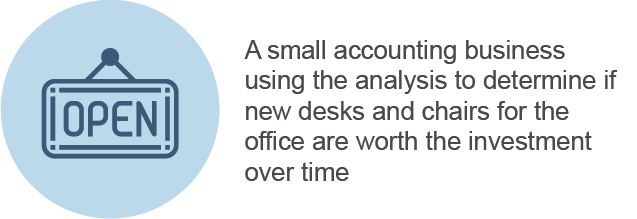
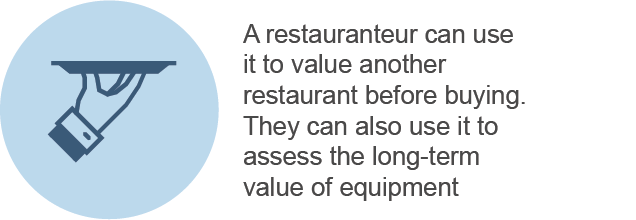
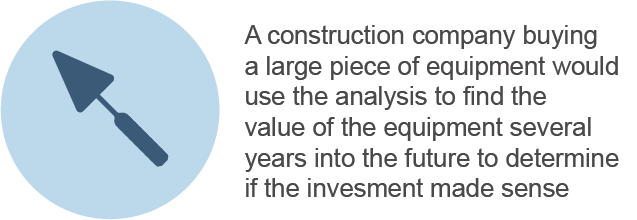
A large construction company can buy a smaller company as a way to expand. The construction company buying a smaller specialty business would use the Discounted Cash Flow analysis to not only find the value of the smaller company, but also to determine if the investment makes sense long-term.
Even a restauranteur can use the Discounted Cash Flow analysis. Similar to the example with the construction company, a restauranteur can use the Discounted Cash Flow analysis to value another restaurant before buying. Restauranteurs can also use the analysis to assess the long-term value of buying an expensive piece of equipment.
The same principle could be applied to other small businesses—even if they’re in a position to buy another company, the Discounted Cash Flow analysis can be used to help determine the value of a long-term investment.
Discounted Cash Flow: Helping Determine the Value of an Asset
If you need to know if it’s worth the investment to buy a business, piece of equipment, or any other asset, the Discounted Cash Flow can help.
By adding up the projected cash flows within a certain time period and discounting the money to the net present value, the Discounted Cash Flow analysis can show you how much money you’ll get in return from your investment.
As a small business owner, you’re an expert, too. We want to hear about how you feel about discounted cash flow. Let us—and your fellow SBOs—know by sharing a comment below.






Great Article! Thanks a lot.
You’re welcome! We’re glad you liked it!
Great article! It was articulated superbly and helped me get past some roadblocks I ran into from class.
We’re so glad it was helpful, Andre!
Thank you for the piece of valued information